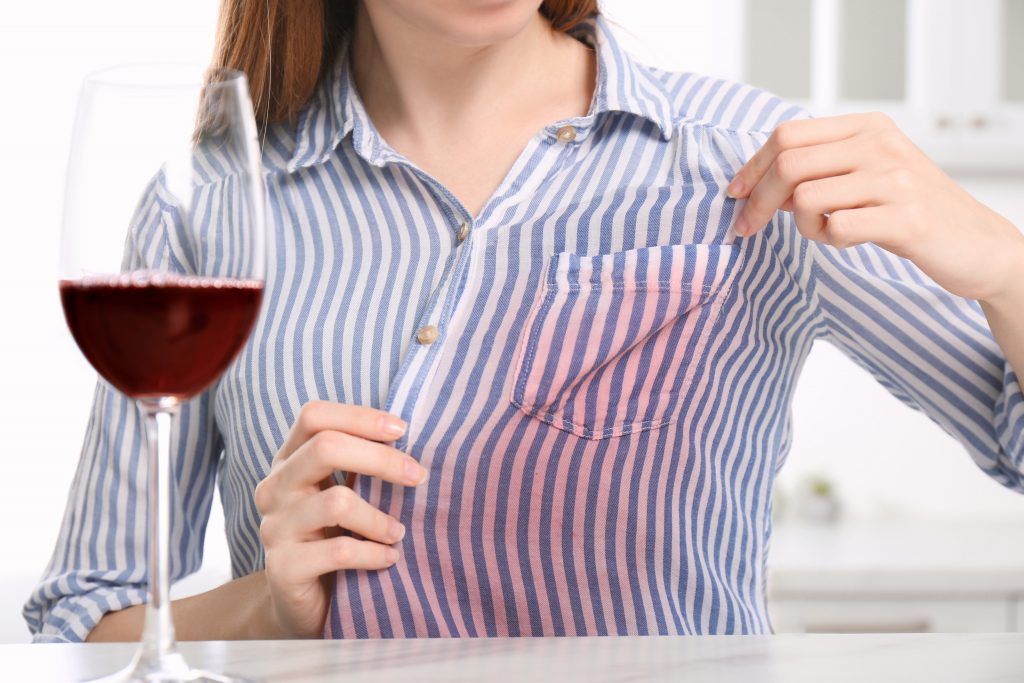 Get How-To's
Get How-To's
How To Get Blood Stains Out of Clothes
Discover price transparency and savings in our Calculator!
Read tips, tricks, and how-to’s on our Fabric of Life blog.
How-To's

Cotton and polyester are among the strongest fabric types, meaning they can endure a more aggressive treatment process while delicate fabrics may require a gentler method of cleaning wine stains, which are technically considered tannin stains.
Wine stains can be frustrating, but can be removed using common cleaning agents like hydrogen peroxide, club soda, white vinegar, or even salt. While these stains, especially red wine can be tough to remove, they aren’t impossible. The quicker you address the spill, the better your chances of preventing it from setting in.
It probably doesn’t come as a shock that red wine stains are generally more challenging to remove than white ones. This is because of the tannins present in red wines. The dark pigments of red wine can immediately soak into fabrics, especially if the material is porous.
Tannin stains act as natural dyes, binding to the fabric fibers, making removing them difficult, especially when exposed to heat or allowed to dry. Keep in mind that the longer these stains sit on the affected area, the more difficult they will be to remove.
White wine stains, on the other hand, are less noticeable but still cause damage to fabrics. Interestingly, white wine can sometimes help dilute and neutralize red wine stains when applied to stained fabrics immediately after the spill occurs.
When dealing with wine stains, time is critical. Immediate action is your best bet to completely remove the stain. Simple household items like table salt and club soda are great defenses for fresh stains.
Believe it or not, pouring salt on a fresh wine stain can help to absorb the liquid and prevent further spreading. Table salt works surprisingly well when used to remove red wine stains as it helps pick up the pigments staining the fabric.
To use salt, pour a generous amount on the wine stain. Use a bit of cold water and a toothbrush or another small bristle brush to gently scrub in a circular motion. Rinse with cold water and repeat as needed. In addition to salt, add a bit of baking powder which can help ease and lift the stain as well.
Club soda or soda water is a staple when lifting a wine stain from fabric fibers. The carbonation in the water helps to break up the components and tannins of the wine, helping to dissipate the stain. Adding a bit of baking soda can further increase your chances of returning wine stain clothes to their previous stain.
Be sure to dab the stain up before scrubbing gently in circular motions. This will prevent you from rubbing the stain deeper into the garment.
The best technique for removing wine stains depends on the type of stained fabric.
Cotton and Polyester are among the strongest fabric types, meaning they can endure a more aggressive treatment process. Follow these steps to remove a wine stain from your favorite cotton and polyester fabrics/garments:
To start, gently blot the stained area with a clean cloth or paper towel to absorb the spilled wine. Avoid rubbing the stain, as this can push the liquid deeper into the fabric instead of removing it.
Next, take cold water and rinse the stained area. Cold water helps lift the stain, allowing you to rinse it away or absorb it with a cloth. Bear in mind not to use warm water as it will likely set the stain, making it much harder to remove.
Finally, mix one part liquid detergent or dish soap with one part hydrogen peroxide. Take a toothbrush or another small, bristled object and gently scrub in circular motions. Consider starting on a small inconspicuous area of the garment first to ensure no negative reactions before moving on to the larger, more noticeable areas.
Delicate fabrics will require a gentler method of cleaning. Here are the key steps to removing a wine stain from a delicate fabric without damaging it:
If you have read from the beginning of this article, you will know that blotting is a common theme across all wine stain removal. It’s no different for delicate fabrics. In fact, it is especially important to first blot the wine stain gently to remove any excess liquid.
To remove wine stains gently, you can create a mixture using equal parts of white vinegar and liquid detergent. Pour the mixture onto the stain and allow it to work by breaking apart the wine, making it easier to absorb from the fabric.
Finally, sprinkle baking soda or talcum powder over the stain to absorb the liquid. When the powder absorbs the detergent/vinegar mixture, the hope is that it will draw the pigments from the wine out as well.
Don’t forget this: Spills happen, and not just on our tablecloths and clothing. Sometimes, these spills occur on our favorite area rugs or white dining room carpet. The good news is we have a solution to remove these wine stains but act fast because time is of the essence.
Use a dry rag or paper towel to blot as much wine as possible. Avoid rubbing, as this can push the wine stain deeper into the fibers. Blot gently to lift the excess liquid without spreading it further.
Sprinkle a generous amount of table salt over the stain. The salt helps absorb the moisture and prevents the stain from setting. Pour club soda over the salted area to loosen the stain, then gently blot with a white cloth. The carbonation in the club soda works to lift the stain from the rug fibers.
For white rugs, mix part hydrogen peroxide with liquid laundry detergent. Carefully blot the stained area with a white cloth, using light pressure. The hydrogen peroxide helps to break down the wine’s pigments, while the detergent removes the residue, leaving the rug cleaner and fresher. Repeat the process if necessary for stubborn stains.
Sometimes you will need to invest in a store-bought stain remover in order to remove the tougher stains such as dried wine or deep red wine on a carpet. These cleaners are made to tackle stubborn stains from wine to coffee stains.
it’s important to keep in mind that store-bought cleaners are tough on stains, meaning they can also be tough on fabrics. Before using a store-bought stain remover, it’s a good idea to test it on an inconspicuous area of the garment to ensure no negative effects.
If the wine stain persists after your DIY efforts, or if you’re unsure about how to treat certain fabrics, it’s best to seek the expertise of a professional. Attempting too many methods at home can sometimes make the stain worse, so knowing when to hand over the job to a pro is key.
A dry cleaner, on the other hand, has cleaning agents designed to safely and effectively remove tough stains without damaging the material. Don’t risk your clothing, linens, or upholstery by over-scrubbing or applying too many harsh chemicals.
Why take the risk of damaging your fabrics when you can leave the stain-removal process to the experts? CD One Price Cleaners offers professional and reliable stain removal services that can handle even the most challenging red wine stains.
Whether you’ve spilled wine on a delicate silk blouse, a favorite pair of jeans, or even your white carpet, we can help. Bring your stained items to a CD One Price Cleaners near you, and we’ll take care of the rest. With affordable prices and a commitment to quality, your clothes and home fabrics will look as good as new.
Visit our website today or stop by your nearest location to see how easy it is to save your favorite items from those pesky wine stains!
We think you may like
 Get How-To's
Get How-To's
How To Get Blood Stains Out of Clothes
 Get How-To's
Get How-To's
How To Get Out Grass and Mud Stains
 Get Garment Guides
Get Garment Guides
How to Clean Your Area Rug At Home